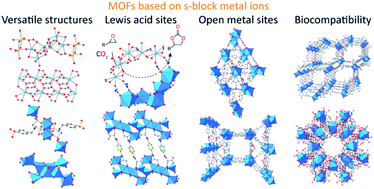Chemistry and applications of s-block metal–organic frameworks
Abstract
Metal–organic frameworks (MOFs) are crystalline porous materials with a broad range of practical applications. A plethora of MOFs based on a variety of metal ions including s-, p-, d-, and f-block elements have been developed over the past decade. Despite the abundance, cheapness, and recognized non-toxicity, s-block MOFs are less explored than those of MOFs based on transition metals and f-block metal ions. Given that s-block MOFs adopt outstanding features (e.g., low density, dense Lewis active centers and open metal sites, biocompatibility, and high catalytic activity), they have been used for potential applications such as gas storage and separation, chemical delivery, catalysis, electrochemical applications, and sensing. This review includes the recent advances of s-block MOFs. The properties of MOFs based on s-block metal ions are the first aspect in our discussion; the second one is the description of the chemical structures of s-block MOF constituents including organic linkers and metal clusters; furthermore, the function of crystal structures and applications of s-block MOFs are specially addressed in gas sorption and separation, chemical delivery, catalysis, sensing, and others types of practical applications. Providing viewpoints on how to expand the scope of s-block MOF chemistry is considered as our final goal in an attempt to orient the chemistry, properties, applications, and future directions of s-block MOFs as advanced materials for multiple purposes in the future.

- This article is part of the themed collection: Journal of Materials Chemistry A Recent Review Articles


 Please wait while we load your content...
Please wait while we load your content...